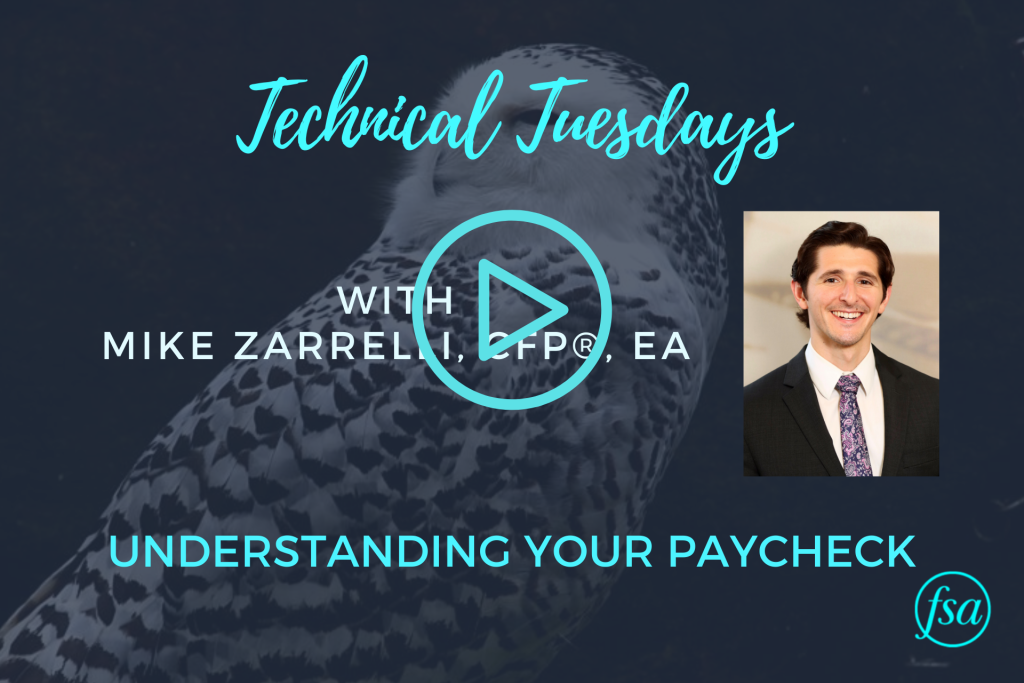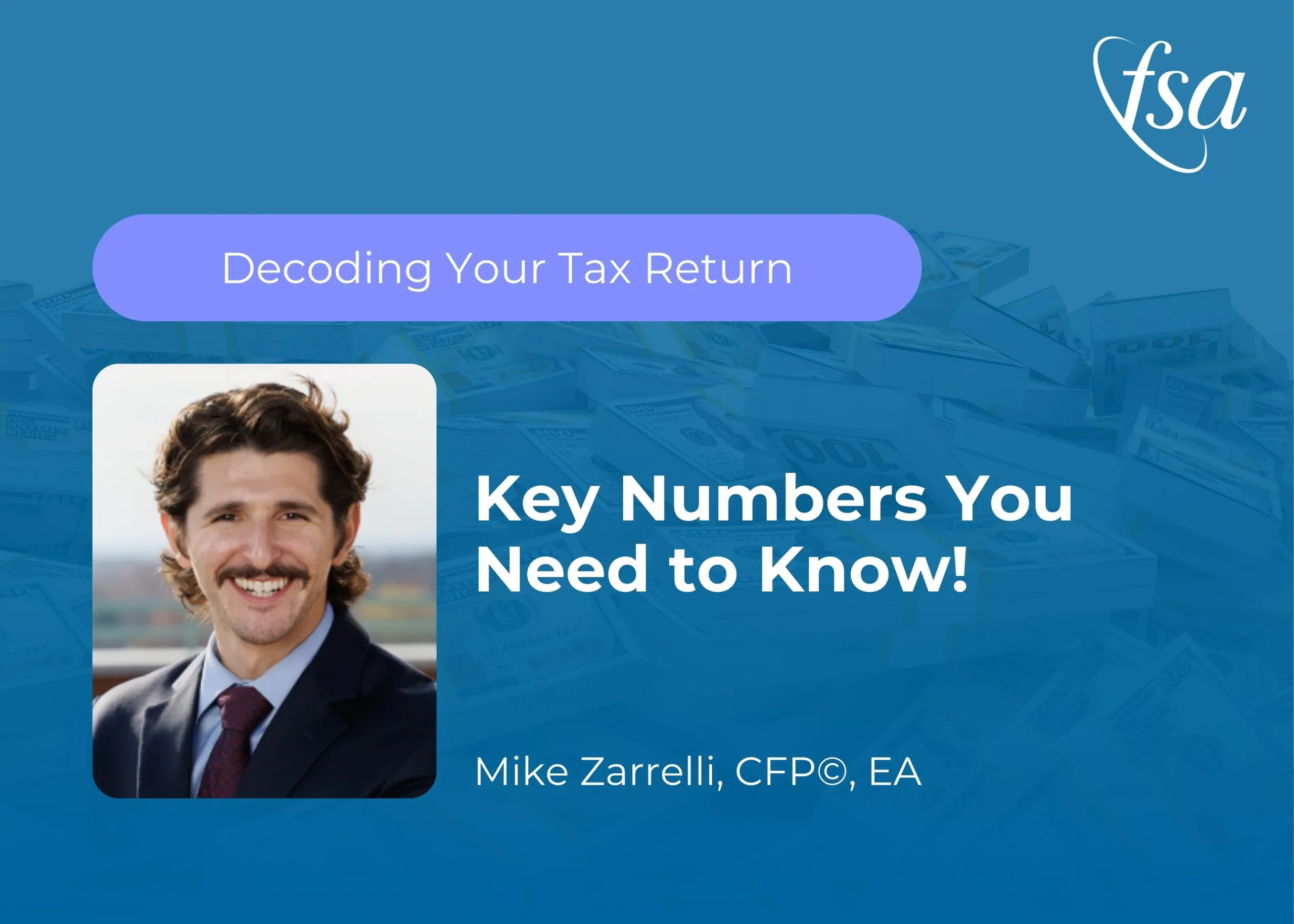In this month’s Technical Tuesdays video, Mike dives into items to pay attention to on your next paycheck.
Understanding Your Paycheck Transcript
Hey, everyone. Thanks for joining this month’s Technical Tuesdays. I’m Mike Zarrelli, and today I’m going to be diving into a sample pay stub. We’re going to look at the different line items that you should be paying attention to on your next paycheck. This is a crucial skill for all types of workers, so let’s dive right in and get you caught up on reviewing your paycheck.
So, I’ve got this sample paycheck we’re going to be looking at Jim John, who is a good friend of mine, works at The Financial Company, and he earns about a $100,000 a year, and he gets 26 paychecks per year, a bi-weekly paycheck. So, if we take that $100,000 that he earns, we’re going to be able to find out about his gross income, which is the first line item on our list right here, gross earnings or gross income. If we take that 100,000 and divide it by 26, yes, that’s right, we get the $3,846.15. Of course, this will be calculated for you, but nonetheless, not bad to check out.
Next items on our list are going to be pre-tax deductions. So I’m going to skip down here and hit deductions. But with deductions there’s two types, and the first type we’re going to focus on is the pre-tax deductions. Now these are going to be things that are taken out of your paycheck before the taxes are calculated. Now this can include a 401(k) that has pre-tax contributions, maybe dental insurance – they give you a little tax break on that, and others will be health insurance or an HSA contribution. So again, this will ultimately lower your tax bill because you’re making pre-tax contributions.
I do want to take a second to talk about one of the best vehicles for saving for retirement, this 401(k). It is a great way to save for retirement, and a lot of times employers will offer a match to your contribution. So, for example, maybe they’ll match 100% of your contributions up to 3%. And, I mean, it’s free money, so why not contribute 3% to get that 3% match from your employer. It’s a slam dunk. Now, of course, contributing more to your 401(k) is probably encouraged, but it all depends on everybody’s situation. So talk to a financial advisor; they’ll help you get a customized number on how much you should be contributing to your 401(k).
Okay, so that’s enough about deductions. We’ll talk about taxes next, this bucket. And as we all know, it is going to be one of the biggest amount of deductions from your paycheck, from that gross income down to your net income. And it mostly comes from three different aspects. So this is the federal withholding right up here. Then we have some state holding from Maryland. And then we have the FICA taxes, which those taxes cover the Social Security and the Medicare benefits. So, it’s always good to double-check your withholdings. If you consistently owe money at the end of the year when it comes tax time, maybe it’s time to update those tax withholdings. And the opposite is true as well. If you consistently get high refunds, maybe you don’t need to be withholding as much, and you can enjoy those monies throughout the year, throughout those 26 paychecks instead.
Next up, we’re going to go back down to deductions because now we have our after-tax deductions. And the primary ones are going to be, again, the 401(k) can fall into this after-tax deduction bucket, that is, if it’s a Roth 401(k) contribution. And that’s a whole other video, whether it makes sense to do pre-tax or Roth contributions to your 401(k).
But also it’s going to be, after-tax deductions are going to include some of those insurances that you’re going to pay for. So for example, disability, that’s paid with after-tax dollars. Life insurance, again, paid with after-tax dollars. So, you’re not getting an upfront tax benefit, but they can provide some tax benefit down the road. So for example, a Roth 401(k), you get to withdraw that money out tax-free at the end of the day when you are retired. Life insurance, if you pass away, that benefit goes to the beneficiaries tax-free. Disability, if you’re the one paying those premiums and you become disabled, that monthly benefit is not taxable. Whereas if the employer is paying for your disability insurance and you become disabled, that monthly benefit will be taxed.
Next up, we’ve got some other line items to pay attention to. Specifically, it’s going to be your benefits. Jim John, in this example, he’s got some PTO. He’s got a balance of 40 hours that he’s already working with. and he’s used eight hours this period and five hours that he’s accrued. Always a good idea to double-check and just do an audit that it’s being accounted for correctly. Nobody wants to get jipped on their time off.
And that kind of goes with all of these in general. Most times there’s not going to be any mistakes or miscalculations on your paycheck, but it’s never a bad idea to double-check because it’s going to be a lot easier if there is an issue to tackle it right as it happens versus noticing it weeks and weeks later and then having to go back with HR to find out how to fix that situation.
So, then last up is the net pay. After all of those deductions, all of those benefits, you come to the net pay. So, started with $3,815 of gross pay, and now we’re down to $2,310. And it’s super important to know this number because this is going to help you with your budgeting. If you know you get paid $2,300 per paycheck, you times that by two, most months you’re going to receive $4,600 going into your checking account each month. So, that’s a great place to start when you’re figuring out how much can you afford to spend each month.
Well, that wraps up this video, this Technical Tuesdays. I hope now you’re more equipped to review your paycheck. It’s always a great idea to audit it. And if you’re not quite sure of something on your paycheck, seek a financial advisor. We look at these all the time and have seen various different situations. Each paycheck is a little bit different, so having a professional take a look at it we’ll help you find out what the right answers are.
Thanks for watching. We’ll see you in the next video.
FSA’s current written Disclosure Brochure and Privacy Notice discussing our current advisory services and fees is available at www.fsawealthpartners.com/disclosures or by calling 301-949-7300.




